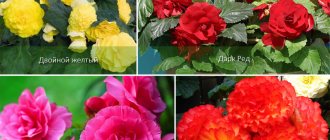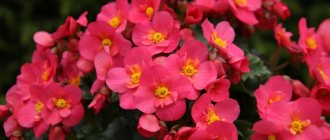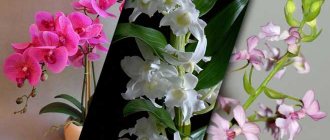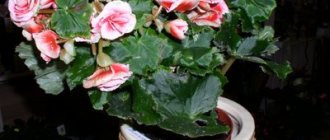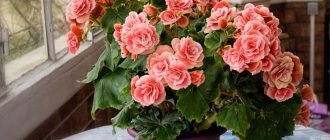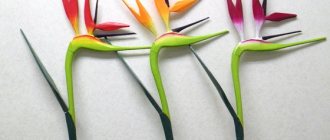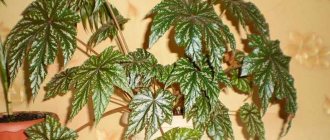Among flowering plants, tuberous begonia is popular. If you properly care for this plant, it will bloom profusely with beautiful double flowers that resemble roses.
The flower looks original in hanging vases, pots and containers on the balcony. In the summer it is planted in open ground, but it does not tolerate winter, so the tubers are dug up in the fall and stored at home until the next season.
Popular types and varieties
Tuberous begonia can be grown indoors and outdoors. All begonias are divided into subspecies, paying attention to the size of the flowers.
The following types are found:
- ampelous;
- small-flowered;
- medium-flowered;
- large-flowered;
- erect.
Erect tuberous begonias are grown at home and in open ground. One of the most popular representatives of upright houseplants is the Harlequin Picoti variety. It differs from other plants in its double yellow flowers with a red border. They are classified as medium-flowered and reach a diameter of up to 12 cm.
The ampelous home variety Chanson belongs to the small-flowered varieties of tuberous begonias. The diameter of the flowers is about 6 cm. They come in a variety of colors: white, yellow, red, orange. Flowers can be double or semi-double. The begonia hangs almost 45 cm from the hanging pot.
Popular flowers include the following varieties of begonia:
| Variety | Description |
| Golden ball | Large-flowered species, diameter can reach 20 cm. Grows well in open ground. |
| Kelblutrot | A plant with large red flowers. |
| Diva | It has unusual corrugated petals, painted in delicate colors: white, pink. |
| Marmorata | Attracts flower lovers with its delicate and lush appearance. The flowers are painted white, with red veins running through them like cobwebs, combined with a red stripe along the edge of the petals. |
| Picoti | The large flowers of the plant are colored yellow, white, and there is a pink stripe along the edge of the petals. |
| Margarita | This ampelous begonia blooms like a camellia. The flowers are medium in size and hang beautifully from hanging pots. |
Tuberous begonia: briefly about the flower
Begonia is a genus of perennial plants from the Begoniaceae family, which includes more than 1,800 species. The genus was named in honor of Michel Begon, the governor of Haiti (1638-1710).
The natural environment of begonias is the humid tropical and subtropical climate of South and Central America, Africa and South Asia. But a large number of species are grown in cooler climates, as indoor plants or even in greenhouses, transferred to open ground in the summer.
Classification of begonias
so complex and branched that gardeners, for convenience, identify several main groups that do not correspond to formal botanical categories. Depending on the shape of the roots, begonias are:
- Tuberous begonias are a herbaceous plant with a club-shaped rhizome. This is a low-growing species, distinguished by long-lasting beautiful flowering. The height of the plant is about 25-75 cm, and the diameter of the flowers can reach more than 20 cm.
- Rhizomatous (ever-blooming) begonias - grow directly from a thick creeping root. They are grown for their unusual large leaves, which amaze with their color and intricate pattern, as well as their texture - smooth, shiny or rough. They do not need to be transplanted during the dormant period.
Tuberous begonia has many varieties, some of them can be grown in open ground, and some only in rooms or indoor greenhouses. Its leaves have a heart-shaped asymmetrical shape and alternate arrangement. The flowers are heterosexual and monoecious, which means that there are male and female flowers on the same bush at the same time. Tuberous begonia seeds are formed only with proper pollination. The tubers are cup-shaped and the seedlings emerge from the cupped area and form roots on all sides of the tuber.
This type of begonia prefers a humid, but not very hot climate and enters a dormant period in winter.
To flower well, tuberous begonia should be placed in a warm area with indirect sunlight, as it does not tolerate cold well and is also damaged by heavy rain.
Features of plant propagation
Tuberous begonia (care at home ensures its flowering) reproduces in several ways. The most difficult thing is to grow begonia from seeds.
Growing from seeds
The most suitable time for sowing seeds is January. Begonias need time for their tubers to grow and form. Then it will have time to bloom in the same year. However, you need to remember about the short daylight hours, so the seedlings will have to be illuminated with a fluorescent lamp. Seeds should be sown following a certain sequence and rules.
Sowing and subsequent care of the plant consists of the following stages:
- Prepare a container and fill it with light, moist soil.
- Spread the seeds on the soil, but do not sprinkle soil on top.
- Place the container in a warm place, near heating radiators.
- Remove the glass every day to allow ventilation. Shoots will appear in 14 days.
- After germination, remove the film or glass.
- Place the container with plants on a bright windowsill, while protecting the seedlings from bright sunlight. To do this, they need to be slightly shaded.
- Water the seedlings in a timely and regular manner and do not let the soil dry out.
- With the appearance of the first permanent leaf, transplant the young plants into separate cups.
It must be remembered: in this type of begonia the tuberous part begins to grow very quickly.
Cuttings
Growing from seeds is considered a labor-intensive process, so many gardeners find it easier to root cuttings. The best time for this is spring or autumn. It is best to take cuttings grown from a tuber. They must be at least 8-12 cm.
In order for cuttings to grow on a tuber, preliminary work should be done. The tubers must go through a period of rest; for this they are placed in a cellar or refrigerator. The duration of this period is about 3 months. You can plant in January.
The tuber is removed, lightly dug into the ground and wait for the cuttings to grow. The temperature should be room temperature - about 20° C. Cuttings are considered ready for rooting when at least 3 leaves grow on them. You can get cuttings from a tuber twice, so when cutting them you need to leave the stem with the lower 3 leaves, cut with 2 leaves. The first flowers will appear in August.
The procedure for rooting cuttings is as follows:
- Take a cutting from a tuber, preferably sprinkle the cut area with ash or coal.
- Wait a few minutes for the cut to dry slightly.
- Deepen the end of the cutting into the soil 1.5 cm, water it with water. For rooting, it is better to use ready-made flower soil.
- Cover the top with a cap: a bag, a jar or a plastic glass.
- Ventilate the plants at least once a day by opening the hood for a while.
In about 3 weeks the roots should grow. The plant should be transplanted to a permanent place of growth, in a pot.
Dividing a bush or rhizomes
The bush of the plant is also divided into parts. To do this, remove it from the container and partially remove the soil by gently shaking it. Then it is cut into 2-3 parts with a knife. The cut areas are treated with ash. Each part must contain roots and about 2 shoots. They are planted in separate pots and watered.
Constant monitoring of soil moisture is necessary. It is advisable to cover the plant from above with a cap, then it will not wither and will take root faster and more painlessly. The tuber is divided in the spring, after buds have formed on it.
The figure shows how to propagate tuberous begonia by dividing the root.
This method is also not considered difficult if you follow the following algorithm:
- Take a plant about 3 years old.
- Remove the plant completely from the pot.
- Cut off the stem and leave the tuber.
- Rinse the tuber to remove soil.
- Take a sharp knife treated with an antiseptic. They cut the tuber into pieces so that each has at least one “eye” - a bud.
- Sprinkle the cut areas with ash or coal.
- To speed up the formation of roots, soak them in Kornevin solution.
- Plant each cut part in a separate container. Deepen it so that the bud is not underground, but outside.
- Water the plant and make sure that the soil does not dry out and the water in the container does not stagnate.
- Cover the top with a bag or plastic cup.
- After the cuttings have grown to a height of about 6-7 cm, sprinkle with soil and cover the rhizomes completely with it.
Leaves
Tuberous begonia (caring for the plant at home has its own nuances and subtleties) when propagated by leaves allows you to get a large variety of young plants.
To do this, you must follow a certain sequence:
- Select the bottom, large enough sheet. He must be healthy and undamaged.
- Cut the leaf along the edges to thick veins.
- Place the sheet on a hard, smooth surface and, using a sharp knife, starting from the middle of the thick vein, cut into triangles. Moreover, there must be a central vein in each leaf.
- Plant the particles in soil, which consists of sand mixed with peat. You can put them on top, lightly sprinkling them with soil along the edges of the sheet, or deepen them vertically, about 1 cm. The bottom cut should be in the soil.
- Cover the container with a bag.
An important condition for rooting is maintaining soil moisture and frequent ventilation of the plants. Sometimes the leaves should be sprayed with a spray bottle.
Young plants will appear in about 2 months. Gradually they will need to be accustomed to growing without a greenhouse, which is opened for a while. As soon as the sprouts grow, they are transplanted to a permanent place.
Propagation of tuberous begonia
Tuberous begonia is propagated by dividing tubers, cuttings and seeds. The most interesting result is obtained from seed propagation, since the new plant exhibits an unusual combination of parental qualities.
Propagation by tubers
occurs in early spring, when shoots appear on newly “awakened” tubers. When they reach 3-5 cm in height, the tuber can be cut into several parts, so that each has a sprout, sprinkle the cut area with crushed coal and plant each piece in the soil for germination. This method is usually used for large tubers of adult begonias.
But in young ones, you can carefully “twist” the shoots, 10-12 cm high, and root them in water or soil, but after first treating the open areas with crushed coal. The plant should be germinated in a room with high air humidity, and the soil can be used the same as for adult plants.
Propagation of tuberous begonia by cuttings
, can be autumn and spring. For spring cuttings, begonia tubers need to be “awakened” in January-February by moving them to a warm room. You can cut cuttings from them only when at least three leaves appear on the sprout. This must be done with a very sharp knife or razor, leaving one leaf on the tuber - it must be left so that the plant does not die. The places where cuttings are cut must be processed and planted in the soil, maintaining a room temperature of +20 +22 degrees and air humidity of 60% -80%.
Autumn cuttings are carried out in early autumn, before the plant begins to go into dormancy, but has already bloomed. The cuttings should be planted in regular begonia soil to a depth of 3-4 cm and left there to overwinter. It is considered normal for the entire upper part of the plant to die; if the cutting has taken root, it will sprout a new sprout in the spring.
Tuberous begonias in the garden do not bloom as luxuriantly as those planted in pots.
Propagation of tuberous begonia by seeds
a rather labor-intensive process with an unexpected result. The plant has very small seeds that can be stored for up to three years, and the sown begonia will bloom only next year. The seeds are sown in special boxes with large drainage holes. A thick layer of drainage is poured onto the bottom, which must be treated with an antiseptic. The soil placed in this container must also be disinfected and thoroughly sifted. It should be watered a day before planting.
Seeds should rarely be sown on the surface of the soil and not sprinkled with anything, but simply sprayed with a spray bottle with warm water and covered with plastic film. The box is placed in a place with a constant temperature of 22-25 degrees, lighting at this stage is not important, the main thing is not bright sun.
Tuberous begonia has a creeping stem type.
It is necessary to ventilate the crops every day, at the same time. The first sprouts usually appear after 15-20 days, after which the container with the sprouts is transferred to a bright, cool place (the temperature should be about 13-15 degrees) - but the film, you can use glass, is not removed. You just need to ventilate the seedlings every day and spray them as needed, but only so that the water does not stagnate.
When the first true leaves appear on the sprouts, you need to pick them at a distance of 2.5-3 cm. Only after this you can remove the film and begin full watering - after all, at this moment the tubers are formed. The next picking should be done when the leaves of neighboring begonias touch each other. To do this, each flower is transplanted into a separate container with a diameter of 8-9 cm. Then you need to transfer the plants into larger pots as they grow.
Begonia planted with seeds is fed a week after the second picking, and after that every 10 days with liquid mineral fertilizers.
Begonia sowing time
The choice of time for sowing begonia seeds depends on the desire: to wait for flowering in the same year or the next.
For example:
- When sowing seeds in January, by summer the tubers will grow, the plant will get stronger and the begonia will bloom in August. However, it must be remembered that additional lighting will be needed. For these purposes, use a fluorescent lamp.
- If you sow seeds in February and March, the plant will not have time to gain strength and will bloom only the next year. But there is no need for additional lighting; caring for seedlings is not so difficult.
Types of flowering begonia
Other types of flowering begonias are also widespread in home culture.
Begonia hybrid Elatior
The lush flowering bush reaches a maximum height of 0.4 m. Fleshy and juicy stems are decorated with regular leaf plates shaped like a heart. The foliage is approximately 80 mm long. Rich green glossy leaf plates have a carved edge. Racemose inflorescences consisting of spectacular flowers are formed on tall peduncles.
Begonia always blooming
This plant is easy to care for. The height of the bush reaches no more than 0.4 m. The stems can be hanging or erect (depending on the variety). The length of the rounded leaf plates is approximately 60 mm, they are pubescent along the edge. The color of the foliage can be very different: from dark green with a burgundy tint to greenish. Small flowers (20–30 mm in size) are distinguished by their fragility.
Begonia ampelous
The plant has drooping long stems. They are often used to landscape terraces, balconies and patios. Densely double or simple flowers can be painted in a variety of colors. This type is suitable for decorating hanging baskets and forming flowering cascades. The bush blooms very luxuriantly and for a long time. Flowers decorate it from the beginning of June until frost.
Selecting a container for sowing
The most suitable container for begonia is considered to be a wide pot, about 8-10 cm high. Considering that the root system develops not in depth, but in breadth, such a pot is good for ventilation and access to oxygen to the roots. The capacity changes as the plant grows and develops.
For a young plant that has only recently taken root from a cutting or leaf, the container should have a diameter of about 6 cm. After 6 months, after the begonia has taken root and grown, it is transplanted into a pot with a diameter of about 12 cm.
You should also pay attention to the size of the plant and its age. When the begonia turns 3 years old, it should be transplanted into a container wider than the previous one. A small begonia should not be immediately planted in a large pot. If there is too much soil, the roots may rot and the soil will not have time to dry out.
Rules for planting seedlings in open ground
The first step is to find a place to land. It should be well lit, but at the same time protected from direct sunlight and strong winds. The plant is planted in early June.
The tuber is pre-treated in a fungicidal solution and germinated. A plant with young shoots should be gradually prepared for planting outside. To do this, the flower is first taken out onto the balcony, and then simply into the fresh air. The duration of stay in the fresh air should gradually increase.
Preparing the planting site involves creating planting holes and filling them with ash or rotted humus. Then the plant is planted. Seedlings should be mulched immediately. Large tubers are planted at a distance of 30 cm from each other, medium ones 20 cm, and small ones - every 15 cm.
What affects germination?
In order for begonia seeds to sprout together, it is necessary to create favorable conditions. These include maintaining optimal temperature and maintaining soil moisture.
It is necessary to wait a maximum of about 3 weeks for seed germination. If they do not sprout, you will need to sow them again. We must remember that it is not easy to germinate begonia seeds. It has been observed that the germination rate is generally around 50%.
Botanical description of the plant
Tuberous begonias with luxurious double flowers were bred by breeders through hybridization. They are also called tube hybrids. Their peculiarity, in addition to the presence of tubers, is the shedding of leaves for the winter and a winter dormancy period. Many varieties of this group are distinguished by luxurious double flowers of a wide variety of colors - white, red, pink, yellow. The colors can consist of their mixtures and be variegated or with a border.
Did you know? All begonias are inhabitants of the tropics and subtropics. Most of them come from South America. These plants also grow in some Asian countries and in the west of the African continent, on the islands of the Malay archipelago.
The flowers of some varieties look like small roses, camellias or carnations. The selection did not stop there and tube hybrids served to create other species. Through complex hybridization, which involved tuberhybrids and Socotrans begonia, winter-flowering begonias were bred. Some of which bloom with double flowers. They no longer belong to tuberous begonias, since they no longer have tubers.
Most tuberous begonias require proper organization of the rest period. Usually they are dug up and stored until spring in cardboard boxes with sawdust at temperatures of +12...+14°C. Terry varieties also have hybrids related to ever-flowering begonias, created on the basis of begonia cape.
Further hybridization made it possible to develop a wide variety of varieties. The flowers come in all shades of red, white and pink, and the beautiful waxy leaves come in green or bronze. There are variegated varieties. These are the most popular groups of begonias, which include terry varieties.
Transplantation to a permanent place
Often, a young plant that has just grown from seeds or leaves has to be transplanted to a permanent place of growth. Sometimes a cutting that has already rooted well is replanted.
For good rooting of the plant, it is recommended to follow the following rules:
- Take a prepared pot, preferably short but wide in diameter.
- Place a drainage layer in the form of pebbles, expanded clay, or broken bricks at the bottom.
- Sprinkle a little charcoal as a protection against waterlogging, about 1 cm.
- Fill the pot halfway with substrate.
- Remove the plant from another pot. If this is difficult to do, in order not to damage it, wet the soil well or place the pot in a basin of water.
- Remove some of the old substrate from the roots and place the plant in the center of another pot.
- Fill the pot with soil, leaving about 1.5 cm on top.
- Be sure to water the plant. If the soil settles a little, it is advisable to fill it up.
- Considering that the root system is damaged during replanting, in order for the adaptation process to go faster, it is necessary to water the soil with Kornevin or succinic acid. The product can be purchased at a pharmacy.
- During the first days, shade the flower from the sun.
Questions and answers
How long does a flower live?
The lifespan of begonia is 2–3 years. However, some varieties with proper care can grow for up to 5 years. The tuberous begonias sold in stores are second-year plants. To rejuvenate a tuber, it should be divided.
How to care for tuberous begonia in autumn?
In autumn, the plant begins a state of dormancy. It lasts until spring. At this time, all excess leaves and shoots are removed. Watering is kept to a minimum. At a temperature of 10 degrees, the plant should be removed to a cool place.
How to wake up tuberous begonia
If the begonia tuber cannot be awakened, then it may be too dry. He can be revived. There are several ways. The first option is to wrap the tuber in a wet towel and place it in a plastic bag. It should be placed near the heating device. The tuber needs to be ventilated once a week.
The second option is to wrap the tuber in a damp cloth, perlite or moss. The plant is placed in a greenhouse.
How many days does it take for begonia to sprout?
In most cases, begonia seeds germinate in 10 days. However, the germination period can last from 8 to 26 days. Tubers begin to sprout only after a few weeks. First they form roots, and only then shoots.
Is it possible to pinch tuberous begonia?
Tuberous begonias do not pinch. Strongly grown shoots are simply suspended or attached to a high base. Hybrid tuberous begonias branch well without pinching.
At what depth should I plant tuberous begonia?
It is recommended to plant the tubers of the plant at a depth of about 5 cm. However, experienced gardeners recommend planting the plant so that the buds are visible. The soil is added as the shoots grow.
How to distinguish tuberous begonia from root begonia
The main difference between tuberous begonia and root begonia is the presence of tubers. This flower can be grown as a perennial garden plant or as an indoor plant. The thickness of the rhizome-tuber is about 5–6 cm. The stem itself is quite thin, but strong.
Why do tuberous begonia leaves curl?
Curling of leaves during the initial stages of growth is normal. This temporary modification will not affect the further development of the flower. This phenomenon is observed because the roots are still weak and the leaves do not have enough moisture.
To ensure normal self-regulation of humidity, a good drainage layer should be made. In this case, a sufficient amount of moisture will enter the leaves and they will not curl.
Home care
Tuberous begonia (care at home must be properly organized) will grow and develop well with proper care.
Temperature
Begonia reacts to ambient temperature. An indicator of no lower than 10° C at night and no higher than 25° C during the daytime is suitable for it. The best temperature is considered to be from 18 to 24° C. Most begonias cannot tolerate air heating above 25° C.
There are begonias blooming in winter. For them, the optimal temperature will be considered to be from 14 to 22 ° C. When the begonia is at rest and only the tuber remains, the temperature can be below 10 ° C. At this time, only frost is dangerous to it.
Spraying
To achieve maximum air humidity, you need to use a spray bottle and spray the plant. However, it should be remembered that it is better not to spray begonia, otherwise you may develop a fungal disease.
For begonias, it is undesirable for water to get on the leaves and flowers; it is better to find other ways to humidify the air. For example, you can place a container of water next to the pot or use moistened material.
For this:
- Take a wide pallet.
- Fill it with a layer of expanded clay. Instead, you can use broken brick, pebbles, vermiculite - any material that is used for the drainage layer.
- Fill the container with water so that the drainage is immersed in it. Place a pot with a plant on this material. It is important that moisture does not enter the pot through the hole at the bottom.
You can also place the container on wet sand or moss to moisturize. But it is advisable to make sure that there are no midges.
Lighting
Tuberous begonia is a light-loving plant; a well-lit windowsill is desirable for it. However, with prolonged exposure to direct sunlight, the plant may get burned. This will be noticeable by the changed color of the leaves, which will lose their decorative effect. When flowering in winter, caring for the plant at home, it will need to be additionally illuminated with a lamp.
Watering
An important condition for good plant development is the organization of timely watering. You need to know that the most intensive watering of the plant is required in spring, summer and autumn. Water in the morning or evening every other day.
In the fall, they begin to gradually reduce watering to once a week. For irrigation, you need to take settled water so that it does not contain chlorine and other impurities. It is important to ensure that all excess water drains into the pan and does not stagnate in the pot.
Priming
An important condition for growing begonias is the quality and acidity of the soil. It is best to take light soil, but containing nutrients. The acidity level should not be high. The finished substrate is sold at a flower shop, or you can choose the correct soil composition yourself.
It should include:
- sand – 2 parts;
- turf soil – 1 part;
- leaf soil - 2 parts.
When preparing a soil mixture, it is necessary that it be sterilized.
Top dressing
It is important to monitor soil fertility; it is advisable to fertilize every 2 weeks in spring, summer and autumn. Nutrient mixtures can be purchased in the form of flower fertilizers for indoor plants. All complex fertilizers for flowers are suitable.
Transfer
Begonia is replanted for various reasons:
- for soil renewal;
- when the plant has grown and is cramped in the pot;
- if the root system has grown greatly.
When transplanting you should:
- Remove the plant from the previous pot.
- Consider its root system and tuber.
- Remove rotten roots, cut off part of the tuber if it is damaged. Sprinkle this place with coal or ash.
- Plant the plant in previously prepared soil.
What kind of land is needed?
Begonia has a weak root system , which is sensitive to excessive soil moisture. The plant feels comfortable in loose soil enriched with nutrients. The soil must be air and water permeable. The optimal pH is between 6.1 and 7.5.
When making your own substrate, you must keep in mind that the leaf soil should not contain tannins, which are contained in willow and oak leaves. Heavy clay soils are not suitable for growing begonias.
It is necessary to use drainage, which is placed at the bottom of the pot before laying the layer of soil.
Resistance to diseases and pests
Tuberous begonia (home care is correct if the plant is not susceptible to various diseases) often gets powdery mildew. The cause of this disease is overwatering the plant, frequent watering and spraying of leaves.
To prevent the disease you should:
- water moderately;
- frequently ventilate the room;
- loosen the soil.
The most common pest of begonias is aphids. At home, it is recommended to destroy it mechanically. For these purposes, it is necessary to wipe the leaves with an alcohol solution. You can use the chemical agent Hom. To obtain a working solution, 1 tbsp. l. The product is dissolved in 2 liters of water. They wipe the leaves with it, after moistening a sponge in the solution.
Another pest of begonias is the spider mite. It's not easy to fight him. For these purposes, use chamomile decoction or soap solution. Chemicals that can be used include: Karbofos and Intavir.
Possible problems
- Fall of leaves . The room is excessively cold.
- Wilting of leaf blades . Tuberous begonia experiences an acute moisture deficit.
- The bush blooms sparingly . The plant is lacking nutrients and may be too dark. Apply fertilizer to the substrate and move the bush to a more suitable location.
- The foliage dries and loses turgor . Excessively low air humidity and heat in the room are to blame for this.
- Yellowing of leaf blades . The room has high humidity and is too cold.
- There are small whitish spots on the foliage . This is a sign of the development of powdery mildew.
- The foliage has spots of brown and black . The bush is affected by a bacterial disease. It needs to be sprayed with a solution of a fungicidal drug.
- The leaves are rotting . This is due to stagnation of moisture in the substrate and droplets of water falling on the leaf plates.
- Pests . Most often, aphids, spider mites and whiteflies settle on such a flower. To destroy them, you will need to treat them with insecticides.
How to preserve in winter
With the onset of September, begonia prepares for autumn, its leaves turn yellow.
During this period it is necessary:
- gradually remove stems and flower buds;
- do not fertilize or water the plant;
- before the onset of cold weather, somewhere in early October, dig up the tubers;
- Place them in a dry, well-ventilated area to dry slightly. It is advisable to remove all existing greenery.
Basement or cellar
It is very convenient to store begonia tubers in a basement or cellar, where a constant temperature is established. It is best to bury the tubers in damp sand or sawdust. Vermiculite and peat are also suitable. The temperature should be around 5°C.
To prevent the tubers from drying out and shrinking, it is necessary to check them periodically, moistening the sand in a timely manner. If rotting is detected, they should be removed immediately. It is necessary to control the consistency of temperature.
Fridge
It is convenient to store tubers in the refrigerator in the fruit and vegetable section. There they will be under constant control. They are placed in a plastic bag with several holes made for air access. Bags with tubers are filled with peat, moss or sawdust. It is necessary to ensure that they are always slightly moistened.
In a pot at home
If the begonia grew constantly at home or was taken outside in a pot, then it can be left to overwinter in it. In the fall, they gradually begin to reduce watering. After the leaves die, just monitor the soil moisture and do not water.
It is advisable to place the pot with the tuber in a cool place for the winter. It’s good if the temperature is 10-14° C. With the onset of spring, the begonia is placed on a light windowsill and watered frequently. Gradually, cuttings grow from the buds.
The beautiful tuberous begonia plant blooms constantly in spring and summer. It is easy to care for. With the help of this hanging plant, you can turn your window sill into a bright carpet at home. If flowers are placed in hanging flowerpots, then they will decorate terraces and gazebos.
How to choose a begonia tuber
In winter, such a variety of bright packages with begonia tubers appear in flower supermarkets that a rare florist will not be tempted. And already here, at the counter, the path begins, every mistake on which negates the expected result. From hundreds of tubers you need to choose the best.
Selection criteria:
- in the package the tuber is stored in a substrate: peat, sawdust, sphagnum;
- the tuber, when lightly pressed with your fingers, is not pressed through, it is not soft, like a ball of thread, but not prickly and dry;
- it is better to choose well-ripened tubers, the diameter of which is more than 4-5 cm;
- transparent packaging allows you to examine the surface: are there any cuts, rotten soft fragments;
- in the hollow of the tuber (this is the upper part), already in the store they are trying to look at the eyes - dormant growth buds.
Even if, having previously examined the planting material through the packaging film, it was not possible to detect buds, this does not mean that the tuber is dead. But the already clearly grown shoots indicate that they urgently need to be planted. Begonia has already woken up.
Important ! Even in the couple of minutes that separates the store from a parked car, and even more so from a bus stop, there is a risk of freezing the begonia. -1°C is enough for her.
Before taking the packaging out of the store onto the street, they wrap it in several layers of paper. If possible, put it in a box. Flower salons that value their reputation offer free winter insulation material for purchases. Taking advantage of this, the florist will bring the begonia home alive.
Use in landscape design
Upright plants are planted in above-ground containers or flower beds. They look great against the background of a decorative “wall”, in a white plastic flowerpot with a back wall, against a background of gray crushed stone or painted pebbles.
The beauty of blooming tuberous begonia will not leave anyone indifferent; it will improve the mood of every person. It is necessary to care for the plant carefully and painstakingly, but in gratitude you will receive beautiful flowering bushes. If you wish, you can arrange a magnificent flowering garden on your windowsill.
Landing
To grow using begonia tubers, terry planting material must be prepared before the cold weather sets in. Having pulled the tubers out of the ground, they are cleaned and the stems are removed. They are stored in sand or peat in a place where the temperature is plus 8-11 ° C.
Planting is carried out from mid-February to May. The method of growing begonias using seeds is troublesome and therefore not widespread. Planting terry begonia on a plot, open loggia or in a winter garden should be done in the beginning or mid-May, the ground should be well warmed up.
A shallow clay pot with drainage holes at the bottom is suitable for growing this plant. Since clay is a porous material, the roots will receive the fresh air they need. For hanging varieties, wide and small pots are considered suitable.
